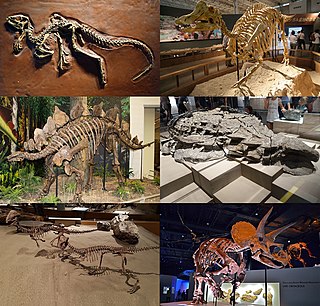
Ornithischia is an extinct clade of mainly herbivorous dinosaurs characterized by a pelvic structure superficially similar to that of birds. The name Ornithischia, or "bird-hipped", reflects this similarity and is derived from the Greek stem ornith- (ὀρνιθ-), meaning "bird", and ischion (ἴσχιον), meaning "hip". However, birds are only distantly related to this group, as birds are theropod dinosaurs.

Ornithopoda is a clade of ornithischian dinosaurs, called ornithopods. They represent one of the most successful groups of herbivorous dinosaurs during the Cretaceous. The most primitive members of the group were bipedal and relatively small-sized, while advanced members of the subgroup Iguanodontia became quadrupedal and developed large body size. Their major evolutionary advantage was the progressive development of a chewing apparatus that became the most sophisticated ever developed by a non-avian dinosaur, rivaling that of modern mammals such as the domestic cow. They reached their apex of diversity and ecological dominance in the hadrosaurids, before they were wiped out by the Cretaceous–Paleogene extinction event along with all other non-avian dinosaurs. Members are known worldwide.
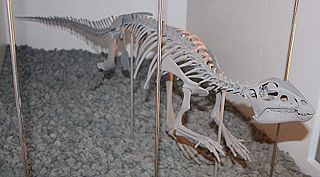
Hypsilophodontidae is a traditionally used family of ornithopod dinosaurs, generally considered invalid today. It historically included many small bodied bipedal neornithischian taxa from around the world, and spanning from the Middle Jurassic until the Late Cretaceous. This inclusive status was supported by some phylogenetic analyses from the 1990s and mid 2000s, although there have also been many finding that the family is an unnatural grouping which should only include the type genus, Hypsilophodon, with the other genera being within clades like Thescelosauridae and Elasmaria. A 2014 analysis by Norman recovered a grouping of Hypsilophodon, Rhabdodontidae and Tenontosaurus, which he referred to as Hypsilophodontia. That clade is formally defined in the PhyloCode as "the smallest clade within Ornithopoda containing Hypsilophodon foxii and Tenontosaurus tilletti provided it does not include Iguanodon bernissartensis". All other analyses from around the same time have instead found these latter taxa to be within Iguanodontia. The family Hypsilophodontidae is formally defined in the PhyloCode by Daniel Madzia and colleagues in 2021 as "the largest clade containing Hypsilophodon foxii, but not Iguanodon bernissartensis and Rhabdodon priscus".
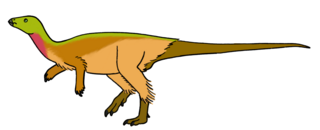
Notohypsilophodon is a genus of ornithopod dinosaur from the Late Cretaceous of Argentina. It was described as the only "hypsilophodont" known from South America, although this assessment is not universally supported, and Gasparinisaura is now believed to have been a basal euornithopod as well.

Parksosaurus is a genus of neornithischian dinosaur from the early Maastrichtian-age Upper Cretaceous Horseshoe Canyon Formation of Alberta, Canada. It is based on most of a partially articulated skeleton and partial skull, showing it to have been a small, bipedal, herbivorous dinosaur. It is one of the few described non-hadrosaurid ornithopods from the end of the Cretaceous in North America, existing around 70 million years ago.
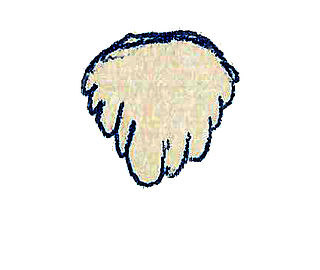
Alocodon is a genus of ornithischian dinosaur known from multiple teeth from the Middle or Late Jurassic Cabaços Formation of Portugal, and also the Forest Marble and Chipping Norton Formations of England. A single species is known, A. kuehnei.

Anoplosaurus is an extinct genus of herbivorous nodosaurid dinosaur, from the late Albian-age Lower Cretaceous Cambridge Greensand of Cambridgeshire, England. It has in the past been classified with either the armored dinosaurs or the ornithopods, but current thought has been in agreement with the "armored dinosaur" interpretation, placing it in the Ankylosauria.
Velocipes is a saurischian dinosaur genus from the Late Triassic that may have been a theropod; its fossils were found in the Norian-age Lissauer Breccia of southern Poland.
Trimucrodon is a genus of ornithischian dinosaur from the Late Jurassic Lourinhã Formation of Portugal. The type, and currently only, species is T. cuneatus.

Anabisetia is a genus of ornithopod dinosaur from the Late Cretaceous Period of Patagonia, South America. It was a small bipedal herbivore, around 2 metres long.

Fulgurotherium is a dubious genus of ornithischian dinosaur from the Late Cretaceous (Cenomanian) Griman Creek Formation. It lived in what is now Australia.

Magnosaurus was a genus of theropod dinosaur from the Middle Jurassic of England. It is based on fragmentary remains and has often been confused with or included in Megalosaurus.
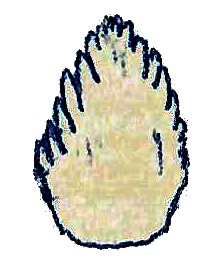
Phyllodon was a genus of small ornithischian dinosaur from the Kimmeridgian-aged Upper Jurassic Camadas de Guimarota Formation of Leiria, Portugal and possibly also the Bathonian-aged Chipping Norton Limestone of England. It may have been closely related to contemporaneous dinosaurs in North America.
Siluosaurus is a genus of ornithischian dinosaur from the Barremian-Albian-age Lower Cretaceous Xinminbao Group of Gansu, China. It is based on the specimen IVPP V.11117 (1-2), which consists of two teeth. It is an obscure genus, with no papers doing more than mentioning it since it was described in 1997. The type species is S. zhanggiani.
Gongbusaurus is a genus of ornithischian, perhaps ornithopod, dinosaur that lived between about 160 and 157 million years ago, in the Late Jurassic period. A small herbivore, it is very poorly known. Two species have been assigned to it, but as the original name is based on teeth, there is no concrete evidence to connect the two species. Its fossils have been found in China.
Priodontognathus was a genus of ankylosaurian dinosaur possibly from the Oxfordian-age Upper Jurassic Lower Calcareous Grit of Yorkshire, England. It is a dubious genus based on a maxilla, and has been erroneously mixed up with iguanodonts and stegosaurs.

Dryosauridae was a family of primitive iguanodonts, first proposed by Milner & Norman in 1984. They are known from Middle Jurassic to Early Cretaceous rocks of Africa, Europe, and North America.
The Twin Mountains Formation, also known as the Twin Mak Formation, is a sedimentary rock formation, within the Trinity Group, found in Texas of the United States of America. It is a terrestrial formation of Aptian age, and is notable for its dinosaur fossils. Dinosaurs from this formation include the large theropod Acrocanthosaurus, the sauropod Sauroposeidon, as well as the ornithopods Tenontosaurus and Convolosaurus. It is the lowermost unit of the lower Cretaceous, lying unconformably on Carboniferous strata. It is overlain by the Glen Rose Formation. It is the lateral equivalent of the lower part of the Antlers Formation.
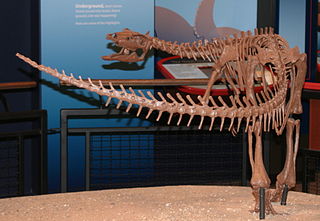
Thescelosauridae is a clade of neornithischians from the Cretaceous of East Asia and North America. The group was originally used as a name by Charles M. Sternberg in 1937, but was not formally defined until 2013, where it was used by Brown and colleagues as the group uniting Thescelosaurus and Orodromeus, based on their phylogenetic results. During a phylogenetic revision of neornithischians by Clint Boyd in 2015, the authorship of Thescelosauridae was given to Brown and colleagues, which meant that the similar name Parksosauridae, informally defined in 2002 by Buchholz, would have had priority over Thescelosauridae. The two clades had slightly different definitions, with Parksosauridae referring to all animals closer to Parksosaurus than Hypsilophodon, but they contained the same taxa so Boyd used Parksosauridae under the assumption it had priority. However, in formalizing the clade following the regulations of the PhyloCode, Madzia, Boyd, and colleagues identified in 2021 that Sternberg was the proper authority for Thescelosauridae, giving it priority over Parksosauridae. As well, they gave Thescelosauridae the definition of the largest clade containing Thescelosaurus neglectus but not Iguanodon bernissartensis, as long as Hypsilophodon foxii was not in the group, modifying previous definitions for Thescelosauridae in order to maintain its modern use, so that the clade was not applied if Thescelosaurus fell within Hypsilophodontidae, a family that has not been recently used but may be revived if the systematic position of Hypsilophodon was solidified at some point in the future. Madzia et al. identified the analysis of Madzia et al. in 2018 as the reference analysis for the name Thescelosauridae, an analysis based on a revised version of the 2015 Boyd analysis.
The Cardiel Formation is a Maastrichtian geologic formation of the Austral Basin in Santa Cruz Province, Argentina. The formation comprises sandstones and conglomerates with abundant tuff beds. The formation is overlain by the Slogget and San Julián Formations and overlies the Divisadero and Kachaike Formations. Dinosaur remains diagnostic to the genus level are among the fossils that have been recovered from the formation.












